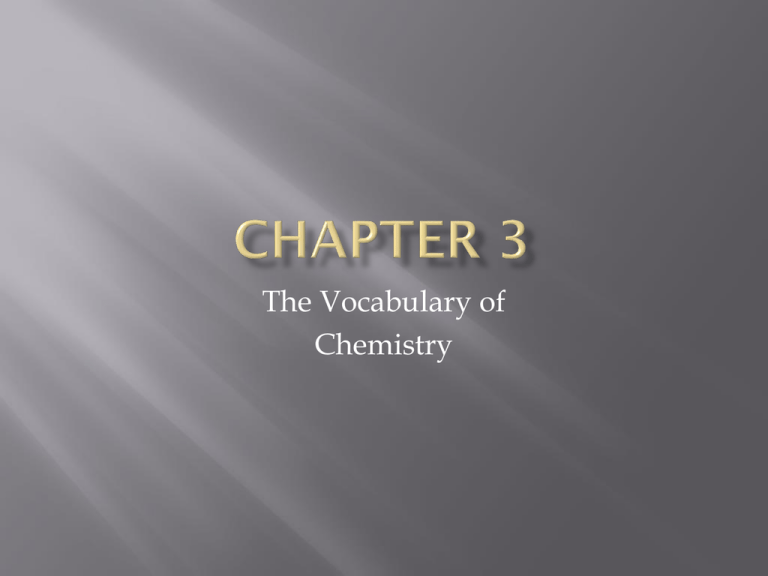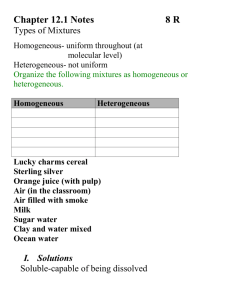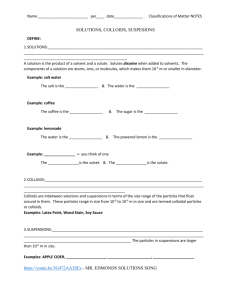Vocabulary of Matter
advertisement

The Vocabulary of Chemistry •refers to the lungs Pneuomono – •above, beyond Ultra – •small Micro – •view Scop – Lung Disease with•the welts resembling element silicon volcanoes, Silic – caused Volcan – by the inhalation •volcano, of fireextremely small Coni – particles•dust of silicaceous dust Osis – •disease or condition. What does it mean? Chemistry is the study of matter. Matter has volume and mass. Matter is described by its properties, which can be either chemical or physical. Chemical properties are properties that can be observed only when substances interact with one another. Reactivity with acid or Burning in the presence of oxygen, for example, is a chemical property. All chemical properties are intensive, which means they do not depend on the amount of matter present. For example, statues made of marble react with acid regardless of the size of the statue. A small piece of chalk (calcium carbonate) and a huge piece of chalk will both react with acid. Physical properties are properties that can be observed or measured without changing the composition of matter. Examples of physical properties are color, texture, shape, length, and mass. Some physical properties are intensive (which means they do not depend on the amount of matter present). Intensive physical properties include melting point, color, density, and texture. For example, a blue piece of paper will be blue no matter how big or small it is. Some physical properties are extensive, which means they do depend on the amount of matter present. Extensive physical properties include mass, volume, and length. For example, the length of a piece of wood depends on how big (or small) the piece of wood is. Properties are characteristics that you can use to describe or identify different substances. (How things look, feel, taste etc.) •State •solid, liquid or gas •Color •color or colorless •Texture •if solid, smooth or rough •Luster •if it is a solid, shiny or dull •Crystal structure •Does the solid form crystals? •What is the shape of the crystals? •Odor •How the substance smells. • strong, weak, pungent, sweet, choking •Solubility •How much dissolves in water? •How much dissolves in other solvents? •Freezing or melting point •At what temperature does the liquid turn into a solid or the solid into a liquid? •Boiling point •At what temperature does the liquid bubble and turn very rapidly into a gas? •Density •Mass of a specific volume of a substance Matter is changed by energy. Energy is the capacity to move or change matter. Forms of energy: potential energy – this is stored energy that is require to keep and object in place. Elevated objects have more potential energy. A car parked on a high mountaintop has more potential energy than a car parked in the parking lot at NAI. Kinetic energy – this energy is due to motion. Only moving objects have this type of energy. The law of conservation of energy states that energy cannot be created or destroyed; it may be transformed or transferred from one object to another, but the total amount of energy in the universe never changes. Physical changes are changes that only affect physical properties; they are changes in form or shape. With physical changes, you get back what you started with, there is no change in a material’s chemical identity or properties. Examples of physical changes: dissolving (including all phase changes) boiling tearing pulling malleability (able to be pounded into a sheet) ductility (able to be made into a wire) sectility (able to be cut with a knife) Chemical changes are changes that produce one or more new substances. With chemical changes, you cannot get back what you started with… Chemical properties have been changed. Examples of chemical changes: all chemical reactions burning digestion fermentation heat is produced light is produced a precipitate (a solid) is produced Turns cloudy new product (usually indicated by a color change) a gas is produced (evolved) Endothermic changes are physical or chemical changes in which energy is absorbed. It will feel cool to the touch. For example, when ice melts, heat is absorbed; therefore, endothermic change occurs. Exothermic changes are physical or chemical changes in which energy is released. It will feel hot to the touch. For example, when a gas cools and becomes a liquid, heat is released; therefore, exothermic change occurs. Matter contains phases. Phases are colors, shapes, and states of matter. For example, a green and white pen has two phases (“the white phase” and “the green phase”). Phases are separated by interfaces. A phase is any part of a system that has uniform composition and properties. For example, with the green and white pen, the line where the green meets the white would be called the “green-white” interface. Matter can be classified as homogeneous or heterogeneous. Matter that has only one phase is homogeneous. Homogeneous matter made up of the same composition (definite formula) is called a pure substance. Pure substances are either elements or compounds. Elements consist of only one type of atom, and cannot be decomposed into simpler substances by ordinary chemical means. Allotropes are multiple forms of one element. Examples of carbon allotropes are graphite, diamonds, and buckyballs. Compounds consist of more than one type of atom chemically combined that can be decomposed into simpler substances (elements) by ordinary chemical means. Organic compounds contain carbon and hydrogen. Sugar (C12H22O11) is an example of an organic compound. It contains carbon (capital “C” with no lower case letters next to it). Inorganic compounds do not contain carbon and hydrogen. Table salt (NaCl) is an example of an inorganic compound. Matter that has more than one phase is heterogeneous. Most things are heterogeneous. Examples of heterogeneous things are oil/water, concrete, and granite. A mixture is a collection of two or more substances physically mixed together, not chemically combined, that retain their identifying properties. A heterogeneous mixture is a mixture containing substances that are not evenly distributed. There are physically distinct parts each with different properties. Examples include oil/vinegar salad dressing and frustration bottles. A homogeneous mixture is a mixture containing substances that are uniformly distributed (same composition throughout with uniform properties). Homogeneous mixtures can either be solutions or colloids. Homogeneous mixtures are composed of a solvent and a solute. A solvent does the dissolving. In a homogeneous mixture there is more solvent than there is solute. For example, in a saltwater mixture, the water is the solvent. A solute dissolves. In a homogeneous mixture there is less solute than there is solvent. For example, in a saltwater mixture, the salt is the solute. States of matter in solution Example gas in gas air (N2, O2 , Ar, CO2 , other gases) gas in liquid soda pop (CO2 in water) liquid in liquid gasoline (a mixture of hydrocarbon compounds) solid in liquid sea water (NaCl and other salts in water) gas in solid H2 in platinum or palladium liquid in solid dental amalgams (mercury in silver) solid in solid alloys ( brass, (Cu/Zn), solder (Sn/Pb) •The main difference between a solution and a colloid is particle size. •Solutions are mixtures with particle sizes at the molecule or ion level. •The particles have dimensions between 0.1 to 2 nanometers. •Colloids are mixtures with particle sizes that consist of clumps of molecules. •The particles have dimensions between 2 to 1000 nanometers. • Typically solutions: • are transparent; You can see through them. •The mixture remains stable and does not separate after standing for any period of time. •The particles are so small they cannot be separated by normal filtration. •Light can usually pass through the solution. •If the solute is able to absorb visible light then the solution will have a color. •A blue liquid transmits blue light and absorbs the other colors of the spectrum. •The colloid looks homogeneous to the naked eye. •Fog and milk are examples of colloids. •Colloids frequently appear "murky" or "opaque". •The particles are large enough to scatter light. •You have experience with the way fog interacts with the light from car headlights. •Colloids generally do not separate on standing. They are not separated by filtration. More Dispersions Liquids, solids, and gases all may be mixed to form colloidal dispersions. •Aerosols: solid or liquid particles in a gas. •Examples: Smoke is a solid in a gas. Fog is a liquid in a gas. •Sols: solid particles in a liquid. •Example: Milk of Magnesia is a sol with solid magnesium hydroxide in water. •Emulsions: liquid particles in liquid. •Example: Mayonnaise is oil in water. •Gels: liquids in solid. •Mostly liquid, but behave like solids •Examples: gelatin is water and protein. •Suspensions are mixtures with particles that have diameters greater than 1000 nm, 0.000001 meter. •The size of the particles is great enough so they are visible to the naked eye. •Blood and aerosol sprays are examples of suspensions. •Suspensions are "murky" or "opaque". •They do not transmit light. •Suspensions separate on standing. •Components of a suspension can be evenly distributed by a mechanical means, like by shaking the contents, but the components will settle out. •The mixture of particles can be separated by filtration. •You can tell suspensions from colloids and solutions because the components of suspensions will eventually separate. •Colloids can be distinguished from solutions using the Tyndall effect. •A beam of light passing through a true solution, such as air, is not visible. •Light passing through a colloidal dispersion, such as smoky or foggy air, will be reflected by the larger particles and the light beam will be visible. Mixtures can be separated according to their properties by the following methods: Filtration – separation by particle size example: coffee grounds and water Decanting Centrifugation Evaporation Distillation – separating substances that have different boiling points Sublimation Crystallization Chromatography – used to separate the components of a solution (can be used to separate colors) Kuwait is a tiny country at the head of the Persian Gulf. Although it has some of the richest oil wells in the world, it has virtually no fresh water. The populations of Kuwait has grown rapidly in recent years as people from all over the world have flocked to this desert kingdom to work in its oil fields. To support the growing population, Kuwait developed massive water desalination plants. In these plants, sea water from the Persian Gulf is heated to boiling. Steam rises from the surface of the water, leaving salts and pollutants behind. The steam is then cooled and condensed to pure liquid water that can be used for drinking, irrigation, or normal household uses. Why do you think desalination is rarely employed to provide water for agriculture? How can the rate of distillation be increased? In 1849 many adventurers came to California in search of gold. Some of the gold-seekers decided to avoid the Sierra Nevada Mountains by venturing south through a large desert basin in southeastern California. Unfortunately, many died of dehydration as they crossed the hot dry valley. The region became known as Death Valley, and is now a National Park. Explain how this apparatus would work. What would be ideal conditions (i.e soil and temperature) for this method of water collection to work? Properties to look at in order to decide separation technique: Density Volatility Solubility Reactivity Magnetism Mixture Element Compound







